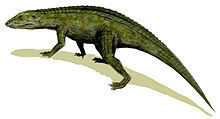

| Crocodyliformes
Temporal range: Late Triassic–Recent, 225–0 Ma
| |
|---|---|

| |
| Protosuchus, an early crocodyliform | |
| Scientific classification | |
| Domain: | Eukaryota |
| Kingdom: | Animalia |
| Phylum: | Chordata |
| Class: | Reptilia |
| Clade: | Archosauria |
| Clade: | Pseudosuchia |
| Clade: | Crocodylomorpha |
| Clade: | Solidocrania |
| Clade: | Crocodyliformes Hay, 1930 |
| Clades | |
Crocodyliformes is a cladeofcrurotarsan archosaurs, the group often traditionally referred to as "crocodilians". They are the first members of Crocodylomorpha to possess many of the features that define later relatives. They are the only pseudosuchians to survive the K-Pg extinction event.
In 1988, James M. Clark argued that traditional names for well-known groups of animals should be restricted to their crown clades, that is, used only for natural groups comprising all living members of any given lineage and descendants of their closest common ancestor. This posed a problem for the crocodilians, because the name Crocodylia, while used in various ways by various scientists, had always included not only living crocodilians but many of their extinct ancestors known only from the fossil record.[1]
Clark's solution to this issue was to restrict the name Crocodylia to the group containing modern alligators, crocodiles, and gharials, plus any extinct taxa descended from their closest common ancestor. The traditional group "Crocodylia" was replaced by the name Crocodyliformes, defined to include many of the extinct families that the new definition left out. Clark did not initially provide an exact definition for Crocodyliformes; but, in 2001, Paul Sereno and colleagues defined it as the clade including Protosuchus richardsoni and the Nile crocodile, plus all descendants of their common ancestor.[2]
Christopher Brochu agreed with the assessment that Crocodylia as a name has never had stable contents, and that a series of clades larger than the crown group Crocodylia (including Crocodyliformes and the slightly more inclusive clade Crocodylomorpha) was a good solution.[3] However, in a 2008 paper, Jeremy Martin and Benton reversed the previous opinion (co-authored by Benton) that Crocodylia should be restricted to the crown group, suggesting that Crocodyliformes should be considered a synonym of a more inclusive Crocodylia, and thus replaced.[4] Brochu and colleagues rejected this proposal, arguing that the crown definition of Crocodylia is the standard meaning both within and beyond the crocodyliform systematics community.[5]
While all extant crocodilians are carnivorous, the ecological roles of Mesozoic crocodyliforms were more diverse, and included omnivory and herbivory. Herbivorous forms were present from the early Jurassic to the late Cretaceous and are thought to have evolved at least three times.[6]
Tracks of a crocodyliform are known since Cretaceous, at least. Tracks representing the ichnofamily Batrachopodidae are described from the Early Cretaceous (late Aptian) Calonda Formation (Angola) by Mateus et al. (2017), who name a new ichnotaxon Angolaichnus adamanticus.[7]
Below is a simplified cladogram based on Fiorelli and Calvo (2007).[8]
| Crocodylomorpha |
| ||||||
In 2012, paleontologists Mario Bronzati, Felipe Chinaglia Montefeltro, and Max C. Langer conducted a broad phylogenetic analysis to produce supertrees of Crocodyliformes, including 184 species. The most parsimonious trees were highly resolved, meaning the phylogenetic relationships found in the analysis were highly likely. Below is a consensus tree based off the study:[9]
| ||||||||||||||||||||||||||||||||||||||||||||||||||||||||||||||||||||||||||||||||||||||||||||||||||||||||||||||||||||||||||||||||||||||||||||||||||||
|
| |||||||||||||||||||||||||||||||||||||||||||||||
|---|---|---|---|---|---|---|---|---|---|---|---|---|---|---|---|---|---|---|---|---|---|---|---|---|---|---|---|---|---|---|---|---|---|---|---|---|---|---|---|---|---|---|---|---|---|---|---|
| |||||||||||||||||||||||||||||||||||||||||||||||
| |||||||||||||||||||||||||||||||||||||||||||||||
| |||||||||||||||||||||||||||||||||||||||||||||||
| |||||||||||||||||||||||||||||||||||||||||||||||
| |||||||||||||||||||||||||||||||||||||||||||||||
| Crocodyliformes |
|
|---|---|